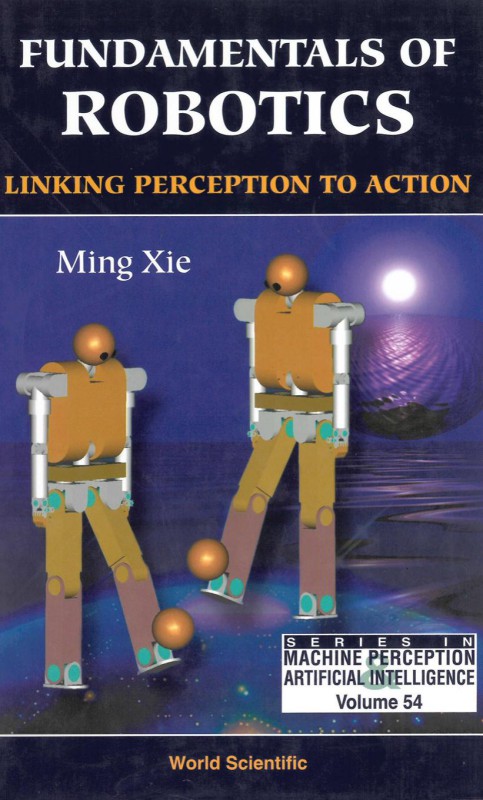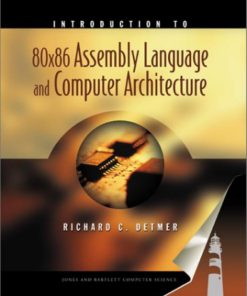Fundamentals of Robotics Linking Perception to Action 1st edition by Ming Xie ISBN ‎ 9812383131 978-9812383136
$50.00 Original price was: $50.00.$25.00Current price is: $25.00.
Authors:Xie, M. , Series:Mechatronics Engineering [156] , Author sort:Xie, M. , Languages:Languages:eng , Published:Published:Jun 2005 , Publisher:World Scientific
Fundamentals of Robotics : Linking Perception to Action 1st edition by Ming Xie – Ebook PDF Instant Download/Delivery. 9812383131 978-9812383136
Full download Fundamentals of Robotics : Linking Perception to Action 1st edition after payment

Product details:
ISBN 10: 9812383131
ISBN 13: 978-9812383136
Author: Ming Xie
Tomorrow’s robots, which includes the humanoid robot, can perform task like tutoring children, working as tour guides, driving humans to and from work, do the family shopping etc. Tomorrow’s robots will enhance lives in ways we never dreamed possible. No time to attend the decisive meeting on Asian strategy? Let your robot go for you and make the decisions. Not feeling well enough to go to the clinic? Let Dr Robot come to you, make a diagnosis, and get you the necessary medicine for treatment. No time to coach the soccer team this week? Let the robot do it for you.Tomorrow’s robots will be the most exciting and revolutionary things to happen to the world since the invention of the automobile. It will change the way we work, play, think, and live. Because of this, nowadays robotics is one of the most dynamic fields of scientific research. These days, robotics is offered in almost every university in the world. Most mechanical engineering departments offer a similar course at both the undergraduate and graduate levels. And increasingly, many computer and electrical engineering departments are also offering it.This book will guide you, the curious beginner, from yesterday to tomorrow. The book will cover practical knowledge in understanding, developing, and using robots as versatile equipment to automate a variety of industrial processes or tasks. But, the book will also discuss the possibilities we can look forward to when we are capable of creating a vision-guided, learning machine.
Fundamentals of Robotics : Linking Perception to Action 1st Table of contents:
Preface
- Introduction to Robotics and Its Relevance in Modern Technology
- Purpose of the Book
- Structure and Organization of the Book
- Target Audience and Prerequisites
Part I: Introduction to Robotics and Perception-Action Systems
-
Overview of Robotics
- Definition and Scope of Robotics
- Evolution of Robotics: From Industrial Robots to Autonomous Systems
- Robotics as an Interdisciplinary Field: Engineering, Computer Science, and Artificial Intelligence
- Applications of Robotics in Industry, Healthcare, and Daily Life
-
Key Components of a Robotic System
- Sensors: Types and Functionality
- Actuators: How Robots Move and Interact
- Control Systems: From Open-Loop to Closed-Loop Control
- Robot Architectures: Serial, Parallel, and Hybrid Systems
- Role of Perception and Action in Robotic Behavior
-
The Perception-Action Loop
- Understanding the Perception-Action Loop: Sensing, Processing, and Acting
- How Robots Use Perception to Guide Actions
- Feedback Mechanisms in Robotics: From Sensory Input to Corrective Action
- Real-Time Processing and Decision Making in Robotic Systems
Part II: Robot Perception
-
Fundamentals of Perception in Robotics
- The Role of Perception in Robot Functionality
- Sensor Technologies for Perception: Cameras, LIDAR, Ultrasound, and More
- How Robots Interpret the Environment: From Raw Data to Information
- Perception Challenges: Noise, Ambiguity, and Environmental Variability
-
Vision Systems in Robotics
- Computer Vision: Principles and Techniques
- Image Processing: From Pixels to Features
- Object Detection and Recognition: Recognizing Objects in the Environment
- Depth Sensing and 3D Perception in Robotics
- Applications of Vision in Navigation and Manipulation
-
Proprioception and Localization
- Understanding Proprioception: Internal Sensors and Self-Perception
- Localization Techniques: Dead Reckoning, GPS, and SLAM
- Simultaneous Localization and Mapping (SLAM)
- Sensor Fusion: Combining Information from Multiple Sensors
-
Environmental Perception and Interaction
- Interaction with Dynamic Environments
- Human-Robot Interaction: Sensing and Understanding Human Intentions
- Robot Social Perception and Adaptability
- Multi-Sensor Perception: Integrating Vision, Touch, and Auditory Sensors
Part III: Robot Action
-
Fundamentals of Robot Action and Movement
- Understanding Robot Actuators: Motors, Pneumatics, and Hydraulic Systems
- Kinematics: Describing Robot Movement and Positioning
- Dynamics and Control: Translating Commands into Movement
- Motion Planning: From Point A to Point B
- Trajectory Control and Path Planning
-
Control Systems for Robotics
- Types of Control: Open-Loop vs. Closed-Loop Control
- PID Control: Basics and Implementation in Robotics
- Adaptive and Robust Control Systems
- Control Strategies for High-Degree-of-Freedom Robots
- The Role of Artificial Intelligence in Robot Control
-
Manipulation and Grasping
- Grasping and Object Manipulation: From Perception to Action
- Dexterous Manipulation: Fine Motor Skills in Robotic Hands
- Grasp Planning: Determining How to Pick Up Objects
- Robotic Arms and End-Effector Design
- Applications of Manipulation in Assembly, Healthcare, and Domestic Robots
-
Locomotion and Navigation
- Types of Locomotion: Wheeled, Legged, and Flying Robots
- Navigation Techniques: Path Planning and Obstacle Avoidance
- Robot Navigation in Dynamic Environments
- Self-Localization for Autonomous Navigation
- Applications of Robot Navigation in Exploration, Delivery, and Autonomous Vehicles
Part IV: Integration of Perception and Action
-
Sensorimotor Integration in Robotics
- The Relationship Between Sensory Inputs and Motor Outputs
- Sensorimotor Control: Principles and Algorithms
- How Robots Learn to Link Perception to Action
- Reinforcement Learning for Robotics: Trial-and-Error Learning
- Real-Time Sensorimotor Feedback Loops
-
Learning in Robotics: From Perception to Action
- Machine Learning for Perception: Supervised, Unsupervised, and Reinforcement Learning
- Transfer Learning and Domain Adaptation in Robotics
- Robot Learning from Demonstration and Imitation
- Deep Learning for Visual Perception and Action Mapping
- Applications of Learning in Autonomous Systems and Personal Robots
-
Autonomy and Decision Making in Robotics
- Levels of Autonomy: From Manual Control to Full Autonomy
- Decision Making Frameworks: Rule-Based, Probabilistic, and Decision Trees
- Planning Under Uncertainty: Markov Decision Processes (MDPs)
- Cognitive Architectures for Robot Decision Making
- Ethical Considerations and Safe Decision Making for Autonomous Robots
Part V: Advanced Topics and Applications
-
Multi-Robot Systems and Coordination
- Coordination Between Multiple Robots: Communication and Collaboration
- Swarm Robotics: Decentralized Control for Collective Behavior
- Task Allocation and Resource Management in Multi-Robot Systems
- Applications of Multi-Robot Systems in Search and Rescue, Surveillance, and Agriculture
-
Human-Robot Interaction
- Principles of Human-Robot Interaction (HRI)
- Social Robotics: Understanding and Responding to Human Emotions
- Trust and Ethical Concerns in Human-Robot Interaction
- Augmenting Human Capabilities with Robotic Assistance
- Applications of HRI in Healthcare, Education, and Service Industries
-
Robotics in Real-World Applications
- Robotics in Industry: Automation, Manufacturing, and Assembly
- Autonomous Vehicles: Linking Perception to Safe Navigation
- Robotics in Medicine: Surgery, Prosthetics, and Rehabilitation
- Robots in Hazardous Environments: Space, Deep Sea, and Disaster Response
- Domestic Robots: Home Assistance and Elderly Care
Part VI: The Future of Robotics
- Emerging Trends and Challenges in Robotics
- The Role of Artificial Intelligence and Deep Learning in Robotics
- Human-Robot Collaboration and Augmented Reality
- Ethical, Legal, and Social Implications of Robotics
- Advancements in Robot Perception and Autonomy
- The Future of Robots in Society: Opportunities and Risks
Conclusion
- Summary of Key Concepts in Robotics: Linking Perception to Action
- The Future of Robotics: Intelligent Systems and the Integration of AI and Robotics
- Final Thoughts on the Evolving Role of Robots in Modern Society
References
- Key Research Papers, Books, and Resources for Further Reading
Index
People also search for Fundamentals of Robotics : Linking Perception to Action 1st:
robotics sensing and perception
robotics fundamentals
autonomous robotics action perception and cognition
google robotics research
introduction to robotics lecture
You may also like…
eBook PDF
Contemporary Approach to Dental Caries 1st Edition by Ming Yu Li ISBN 9535103059 9789535103059












